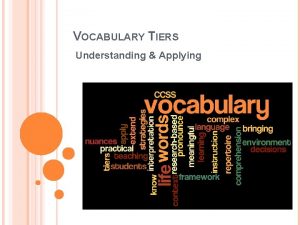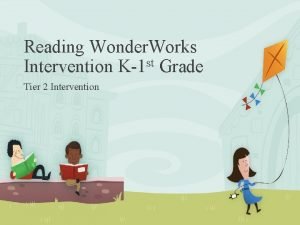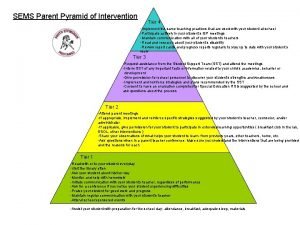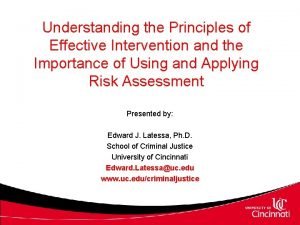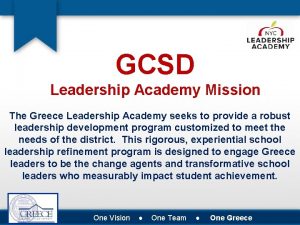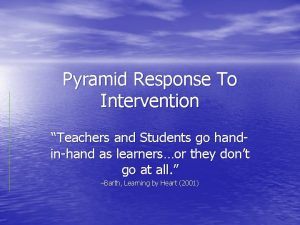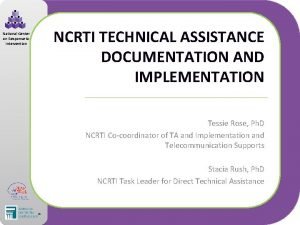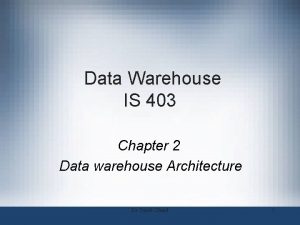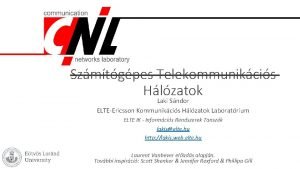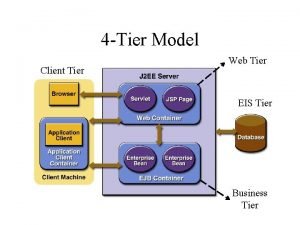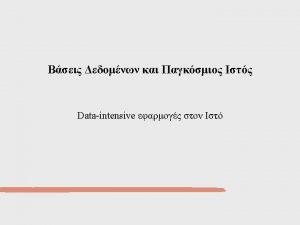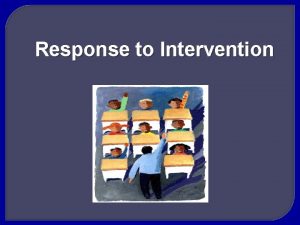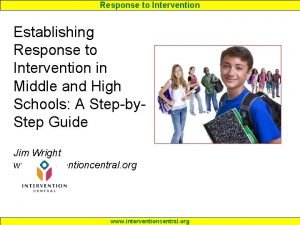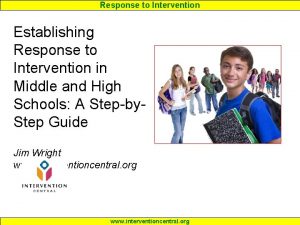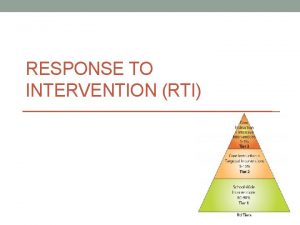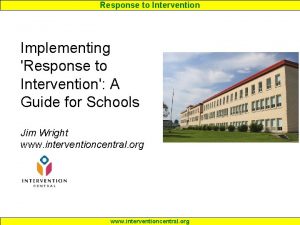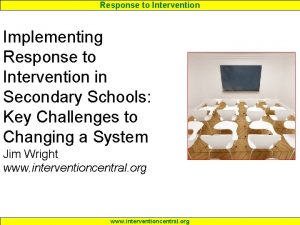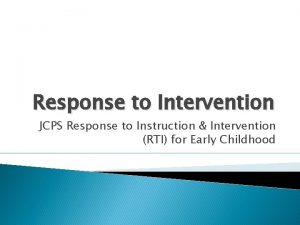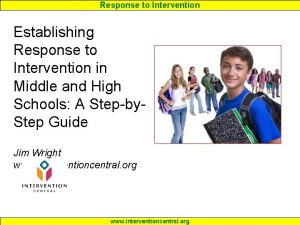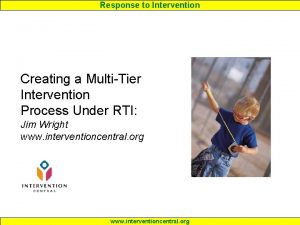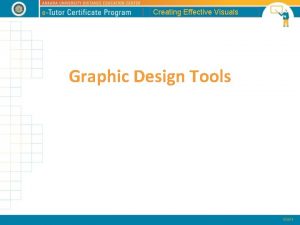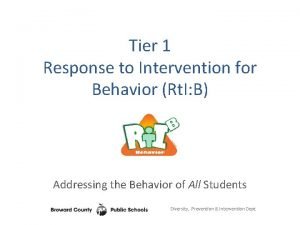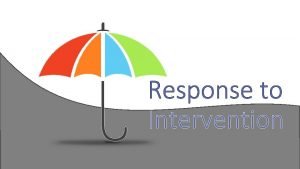Response to Intervention Creating Effective Tier 1Academic Intervention

















- Slides: 17

Response to Intervention Creating Effective Tier 1/Academic Intervention Plans: A Cheat Sheet Jim Wright www. interventioncentral. or g www. interventioncentral. org

Response to Intervention Workshop PPTs and handout available at: http: //www. interventioncentral. org/westbabylon www. interventioncentral. org

Response to Intervention Creating a Classroom Intervention Plan: 3 Steps When putting together a classroom plan to support a struggling student, the teacher goes through these steps: 1. Problem Identification: Define the student problem(s) in specific terms. 2. Intervention: Select at least one intervention strategy to address the problem. 3. Data Collection: Choose a way to collect data to track student progress. www. interventioncentral. org 3

Response to Intervention The Stages of Learning: Common Sources of Student Academic Problems Students move through predictable stages when learning new skills: • Skill Acquisition: The student is just acquiring the skill. • Fluency: The student can perform the skill but must make that skill ‘automatic’. • Generalization: The student must perform the skill across situations or settings. These 3 categories—along with motivation– are the most frequent sources of classroom academic problems. Source: Haring, N. G. , Lovitt, T. C. , Eaton, M. D. , & Hansen, C. L. (1978). The fourth R: Research in the classroom. Columbus, OH: Charles E. Merrill Publishing Co. www. interventioncentral. org 4

Response to Intervention Handout www. interventioncentral. org 5

Response to Intervention Step 1: Identify the Problem: Root Cause www. interventioncentral. org 6

Response to Intervention Handout p. 1 www. interventioncentral. org

Response to Intervention STEP 1: Identify the Problem: Root Cause Type of Student Problem Skill Deficit. Fluency Deficit. Generalization Deficit. Motivation (Performance) Deficit. Definition The student has not yet acquired the skill. The student has acquired the skill but is not yet fluent, efficient, and comfortable in performing the skill. The student possesses the basic skill but does not think to use it in appropriate situations or settings. The student is capable of performing the skill and can identify when use of the skill is appropriate—but lacks motivation to use the skill. www. interventioncentral. org 1

Response to Intervention Step 2: Select the Interventio n www. interventioncentral. org 9

Response to Intervention Handout p. 2 www. interventioncentral. org

Response to Intervention STEP 2: Select the Intervention Type of Student Problem Skill Deficit. Fluency Deficit. General Suggestions for Intervention Teach the student the skill(s) through direct instruction. Reinforce the student for effort and accuracy. (Your documented intervention plan can include an outline of what you plan to teach the student, any methods and/or materials that you will use in your instruction, and a schedule of number and length of teaching sessions. ) Give the student opportunities to practice the skill(s) and then provide timely performance feedback. Reinforce the student for fluency as www. interventioncentral. org 2

Response to Intervention STEP 2: Select the Intervention (Cont. ) Type of General Suggestions for Intervention Student Problem Generalizatio Train the student to recognize situations or n Deficit. settings when the skill(s) should be used. Prompt the student to use the skill(s). Provide incentives for the student to self-monitor and independently use the skill(s) in the appropriate settings. Motivation Use reinforcing strategies to engage the (Performance student in the skill(s) (e. g. , select high-interest ) Deficit. learning activities; offer incentives to the student for successful use of the skill, etc. ). www. interventioncentral. org 2

Response to Intervention Step 3: Choose a Data. Collection Approach www. interventioncentral. org

Response to Intervention Handout p. 2 www. interventioncentral. org

Response to Intervention STEP 3: Choose Data-Collection Approach Type of Student Problem Skill Deficit. Fluency Deficit. General Suggestions for Data Collection Use teacher judgment to select ways to monitor that logically measure progress in the skill area(s) that you are working on. If working on letter-naming, for example, a teacher may keep an ongoing record of those letters the student can accurately name within 3 seconds from flashcards. Administer brief, timed measures to track growth in speed and efficiency on the target skill(s) (e. g. , using teacher-made, DIBELS or easy. CBM materials). www. interventioncentral. org 3

Response to Intervention STEP 3: Choose Data-Collection Approach (Cont. ) Type of General Suggestions for Data Collection Student Problem Generalizatio Choose those target situations/settings to n Deficit. which the student should generalize specific skill(s). In those situations/settings, record when the student (1) successfully displays the target skill(s) or (2) fails to display the skill(s). Motivation Regularly track student work completion (Performance and/or quality of completed work to see if ) Deficit. motivation strategies are successful. www. interventioncentral. org 3

Response to Intervention Activity: What Type of Problem? Pick one of your Tier 1 intervention students. Discuss whether your student falls into one of the 4 common categories of academic problem: skill (acquisition), fluency, generalization, motivation. See if the handout recommendations apply to your student. What additional questions do you www. interventioncentral. org 17
 Teir 3 words
Teir 3 words Tiered vocabulary pyramid
Tiered vocabulary pyramid K-trider level 1
K-trider level 1 Tier 4 intervention
Tier 4 intervention Principles of effective intervention
Principles of effective intervention Simplifying response to intervention
Simplifying response to intervention Response to intervention pyramid
Response to intervention pyramid National center for response to intervention
National center for response to intervention Ncrti
Ncrti Natural and forced response
Natural and forced response What is natural response
What is natural response Primary immune response and secondary immune response
Primary immune response and secondary immune response Keiron bailey
Keiron bailey Advantages of data warehouse
Advantages of data warehouse Tier 1 interventions examples
Tier 1 interventions examples Jkl tier 3
Jkl tier 3 Elte ik telekommunikációs hálózatok
Elte ik telekommunikációs hálózatok Orc 3796
Orc 3796

